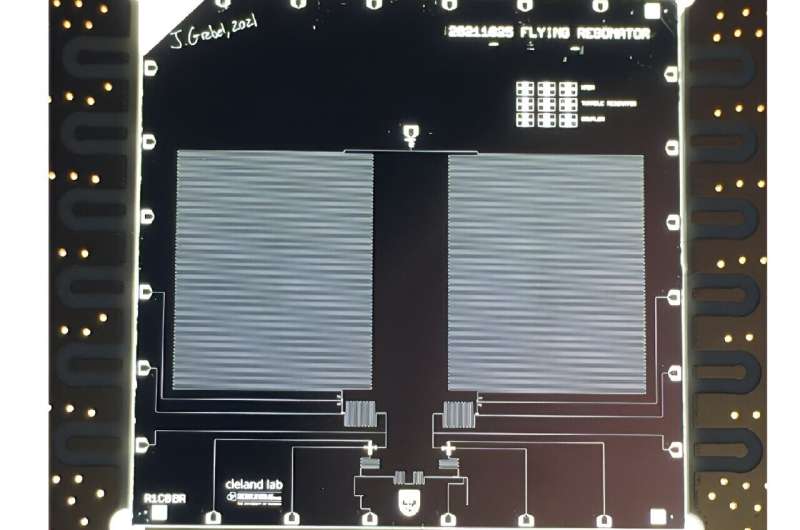February 10, 2024 feature
This article has been reviewed according to Science X's editorial process and policies. Editors have highlighted the following attributes while ensuring the content's credibility:
fact-checked
peer-reviewed publication
trusted source
proofread
Researchers demonstrate multi-photon state transfer between remote superconducting nodes

Over the past few decades, quantum physicists and engineers have been trying to develop new, reliable quantum communication systems. These systems could ultimately serve as a testbed to evaluate and advance communication protocols.
Researchers at the University of Chicago recently introduced a new quantum communication testbed with remote superconducting nodes and demonstrated bidirectional multiphoton communication on this testbed. Their paper, published in Physical Review Letters, could open a new route towards realizing the efficient communication of complex quantum states in superconducting circuits.
"We are developing superconducting qubits for modular quantum computing and as a quantum communication testbed," Andrew Cleland, co-author of the paper, told Phys.org. "Both rely on being able to communicate quantum states coherently between qubit 'nodes' that are connected to one another with a sparse communication network, typically a single physical transmission line."
The researchers' recent study builds on two previous research papers published in Nature Physics and Nature. In these previous works, the team demonstrated that they could generate remote entanglement and send complex quantum states, the latter of which one qubit at a time.
"In our new study, we wanted to try to send complex quantum states representing multiple qubits at the same time," Cleland said. "To do this, we loaded the quantum state to be sent into a resonator and then send the entire resonator state into the transmission line, catching it with a remote resonator for subsequent analysis."
Resonators, devices that exhibit electrical resonance, have a nominally infinite number of quantum levels. As a result, they are theoretically capable of storing very complex states that encode several qubits' worth of data. Due to these advantageous characteristics, using resonators to send and receive data could increase the available bandwidth.
In their experiment, Cleland and his colleagues used two superconducting qubits, each of which was connected to a tunable superconducting resonator. Each of these resonators was, in turn, connected to a 2m-long transmission line via a device known as a variable coupler.
"We use one superconducting qubit to 'program' in different quantum states to its companion resonator, using methods that we established many years ago," Cleland said.
"We then turn on the coupling of the resonator to the transmission line, releasing the (possibly complex) quantum state from the resonator into the transmission line, where it is transmitted as a (possibly complex) set of entangled mobile photons. Those are then 'caught' by the other resonator using the reverse of the release process, and we use that resonator's qubit to analyze the received state. The system can transmit in either direction equally well (thus 'bidirectional')."
The design implemented by the researchers allowed them to realize the bidirectional transmission of single microwave frequency photons, as well as the simultaneous transmission of a two-photon Fock state |2> in one direction with the transmission of a one-photon Fock state |1> in the other direction, as well as the (separate) transmission of superposed photon Fock states |0>+|1> and |0>+|2>.
"We then showed the generation of so-called N00N states, representing entanglement between the two resonators, ultimately realizing first the generation of the entangled state |10>+|01> with one photon 'shared' between the two resonators, then the generation of the state |20>+|02>, with two photons 'shared' in the same way," Cleland said.
"Overall, our work demonstrates a feasible path towards highly efficient communication of more complex quantum states than just single photons between two nodes."
The new quantum communication testbed introduced by Cleland and his colleagues could soon pave the way to further work and advancements. Firstly, it could be used to realize distributed computing, in which every node in a circuit performs computations and efficiently communicates results to another node. In addition, it could be used to demonstrate systems in which two nodes share a complex state, and each performs distinct manipulations on this state.
"Our platform could also be used for quantum communication, where, for example, coded quantum information of some complexity could be transmitted in a single transfer," Cleland added.
"We are now working on a number of different aspects of this experiment; for instance, we plan on increasing the number of nodes (which were two in our recent experiment), increasing the fidelity of the process, and exploring what is possible if we have more communication channels in parallel."
More information: Joel Grebel et al, Bidirectional Multiphoton Communication between Remote Superconducting Nodes, Physical Review Letters (2024). DOI: 10.1103/PhysRevLett.132.047001. On arXiv: DOI: 10.48550/arxiv.2310.00124
Journal information: Nature , Physical Review Letters , Nature Physics , arXiv
© 2024 Science X Network




















